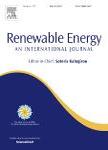版权所有:内蒙古大学图书馆 技术提供:维普资讯• 智图
内蒙古自治区呼和浩特市赛罕区大学西街235号 邮编: 010021

作者机构:Lanzhou Univ Sch Math & Stat Lanzhou 730000 Gansu Peoples R China Lanzhou Univ Sch Informat Sci & Engn Lanzhou 730000 Gansu Peoples R China Dongbei Univ Finance & Econ Sch Stat Dalian Peoples R China
出 版 物:《RENEWABLE ENERGY》 (再生能源)
年 卷 期:2019年第134卷
页 面:681-697页
核心收录:
学科分类:0820[工学-石油与天然气工程] 080703[工学-动力机械及工程] 08[工学] 0807[工学-动力工程及工程热物理]
基 金:Western Project of the National Social Science Foundation of China [18XTJ003]
主 题:Wind energy potential analysis Weibull distribution Data preprocessing Swarm intelligence optimization algorithm
摘 要:Wind energy is an increasing concern for wind farm administrators. Effective wind energy potential analysis and accurate forecasting can reduce the operating cost of wind farms. However, many previous studies have been restricted to analyses of wind energy potential analysis and wind speed forecasting, which may result in poor decisions and inaccurate power scheduling for wind farms. This study develops a wind energy decision system based on swarm intelligence optimization and data preprocessing, which includes two modules: wind energy potential analysis and wind speed forecasting. In the wind energy potential analysis module, the parameters of the Weibull distribution are optimized by a multiple swarm intelligence optimization algorithm, which can provide better wind energy assessment results. In the wind speed forecasting module, the data preprocessing method can effectively eliminate the noise of the original wind speed time series, maintain the characteristics of the wind speed data, and improve the accuracy of the forecasting model. The numerical results show that the wind energy decision system not only provides an effective wind energy assessment, but can also satisfactorily approximate the actual wind speed forecasting. Therefore, it can serve as an effective tool for wind farm management and decision-making. (C) 2018 Published by Elsevier Ltd.